Genre: Beat-‘Em-Up Developer: Appaloosa Interactive Publisher: Sega Ent. Players: 1-3 Released: 1996
Beat-’em-ups have gone through a minor renaissance in recent years. Platforms like PSN, XBOX Live, or Steam and direct distribution have proven fruitful as low budget avenues to revitalize the genre with small releases that, while certainly lacking the polish of big budget productions, still provided a decent amount of quality. Even brands like Double Dragon or Streets of Rage, which had lain dormant literally for decades, saw new installments in their series, though with varying degrees of critical acclaim. These games would never reach the heights and laurels their predecessors did during the third and fourth generations of video game consoles; games like Golden Axe, Streets of Rage 2, Final Fight, and Renegade are regularly mentioned when the best games from the late ‘80s/early ‘90s are being discussed. Regardless, it goes to show that the genre still has its fans even to this day.
The period between, namely the mid-’90s to the middle of this decade, were a different story. Starting with the fifth console generation, the classic 2D brawler entered a dark age. The days of the Sega Saturn and Sony PlayStation also brought the dawn of the 3D era, and while there were a few attempts, introducing a third dimension into the beat-’em-up structure hardly ever worked in the genre’s favor. Most publishers felt that 3D was the definite way to go, which left most classic 2D genres hanging. As a result, brawlers went into decline. While there were a handful of releases during the fifth and sixth console generations, hardly any of them were leaving an impression on the gaming populace at large.
Three Dirty Dwarves is one of the few outliers in that regard. The game was the first release of Appaloosa Interactive, though Genesis fans may be more familiar with the company’s earlier name: Novotrade, the Hungarian developers of Ecco the Dolphin and Kolibri fame. Speaking of which, like those two titles, Three Dirty Dwarves was produced by Sega’s own Ed Annunziata, who also lends his voice to one of the titular dwarves. So, there’s a solid pedigree behind this release. And while there are certain elements that try and mix things up a bit, when it comes to classification, the game is firmly at home in the classic family of 2D brawlers. That alone makes Three Dirty Dwarves a bit of an oddity within its generation.
Odd is also a good way to describe the game’s setting. The titular Three Dirty Dwarves: Greg, Taconic, and Corthag are warriors from a fantasy realm that have been summoned to the modern day Bronx by four hyper-intelligent preteens through their tabletop RPG game. These kids are being held prisoner by one Colonel Waggon Briggs, leader of an organization called Weapon Systems Technology (WST). Thankfully, on arrival the dwarves crash land in a Sporting Goods Department, so they arm themselves with typical American sports regalia – baseballs and bats, football gear, bowling balls and pins, as well as a shotgun (naturally) and make their way through the streets of New York towards the secret government facility where the kids are being held. The dwarves are not the only fantastical creatures that have seeped into our realm though. Aside from bag ladies, security guards, or the weapons and robotics of the WST, the three warriors also have to battle orcs, gnomes, and dragons to reach their destination. The story is framed and sometimes interspersed by a couple of animated cut scenes that, while infrequent, can reach a surprisingly long runtime. As you can probably tell, the whole thing just seeps with ’90s era edginess.
This description should give a rough idea of the off-the-wall nature and the sense of humor the game purports. A lot of detail went into the animations and design of the scenery and the opponents you face along the way. You face orcish street thugs and baseball batters sometimes piloting machinery built from junk (a “tract-orc,” if you will), weird naked and gimp-masked ninjas with a prominent censor bar protruding from their crotch area (skinjas), or a series of Italo-American boxers – must be a Bronx thing. You also, at one or another point, get to fight a dragon occupying an entire apartment block, a gym house (yes, you fight the house itself) and a giant headless fried chicken, among other things. The areas you battle your way through are likewise Bronx-inspired and feature the streets of New York’s famed borough at night and day, as well as locally famous sites like the Taconic Parkway (one of the dwarves is indeed named after a street) or Riker’s Island prison, all represented in a satiric-comical fashion infused with fantasy.
The soundtrack plays into this atmosphere with lots of rock riffs and a certain “industrial” quality to it. It’s not completely streamed from CD, as it has the distinctive midi twang of chiptune sound to it, but the quality is okay for what it tries to accomplish. The visual style can best be described as some sort of mix between the crude leanings of Beavis & Butthead and the Saturday morning cartoon vibes of something like Street Sharks, injected with a heavy dose of AD&D trappings. If that appeals to you, then this might just be your thing. The animation is fun, especially during gameplay, and the cut scenes are entertaining as well, albeit a bit cheap in nature. the Saturn had surprisingly decent FMV capabilities when compared to the competition, but the cut scenes do play at an uncomfortably fast speed. I don’t know whether that’s the result of compression but watching the clips at 75% speed on YouTube feels way more natural and pleasant than what the System itself provides during gameplay. Apart from that, I found the audiovisual style surprisingly entertaining.
The players take control of the Three Dirty Dwarves themselves and if you play alone, that means you get to control all three of them, switching between each of them at the press of the L or R button. Think of it as some sort of Lost Vikings in the guise of a brawler, if you will. The three warriors play relatively similar for the most part, but there are some minor differences. The most apparent are the distinct ranged attacks. Corthag can fire his shotgun, which is quick to attack with but takes longer to reload. Greg throws a baseball in the air and then whacks it at his opponents with a second button press, resulting in a long windup but faster ‘reload’ speed. Taconic’s attack, rolling a bowling ball, lies somewhere in the middle between those two: It has a slightly longer windup than Corthags shotgun blasts, but the ball stays longer on screen and can potentially hit multiple enemies in a row. Effectively these three attack types are a bit unbalanced: Corthag’s shots are preferable over the two other dwarves’ abilities, even considering his slower reload time, since it can hit enemies instantly over distance. Compare this to Greg’s baseballs, which have such a long windup that by the time you are finally ready to attack, your opponent might already have moved out of the line of fire. Greg might be a tad more efficient in his melee attacks but not to a significantly noticeable margin. By the way, from a game design perspective it strikes me as a bit strange that two of the dwarves would deliberately limit themselves to baseballs and bowling pins when actual shotguns are a viable option. That seems like an unnecessary handicap to me when going into combat against orcs and dragons. Then again, I’m not a dwarven warrior summoned from some fantasy realm through the imagination of a preteen super genius (at least I don’t think I am) so what do I know?
In two-player mode, two of the dwarves are controlled directly by the players, and the third can be tagged in by either player one or player two whenever they feel like. If you use a multitap, a third player can join in as well. Only then does every player have to take over a fixed character. It’s when played cooperatively that Three Dirty Dwarves really gets to shine, as switching out the characters manually while on your own takes a while to get used to before you can really get a decent flow going.
Atypical for most beat-’em-ups is the fact that your dwarves don’t have a life bar – at least, not in the regular sense. Rather, the dwarves themselves are your hit points. If the character in control gets hit, he drops to the ground stunned and is immediately switched out for another dwarf not actively controlled. Hitting the dazed warrior with a melee attack gets him right back to action. When all three dwarves are out of commission that you lose a life or rather, fail the stage, since this mechanic also means that there’s no life system in a regular sense.
What Three Dirty Dwarves does have instead are so-called “health skulls.” Picking up skulls or 20-sided dice – another nod to the RPG tropes in the game – throughout the stage or left behind by defeated enemies fills a meter at the top of the screen. The dwarves can use these skulls to pull off three types of special attacks. Two of them, a stronger version of their regular ranged attack and a “Morph Dwarf” allowing for an even more devastating volley, are stationary, while the third has all three dwarves rolling around the scenery in a brawl that damages anything in their path. Usually skulls can be acquired aplenty, so you can feel free to just let loose with special attacks. In hard mode, however, the health skulls also double as a health meter. Once depleted, you fail the stage, so you have to be careful regarding when to utilize your special attacks when playing on the hardest difficulty.
The game also tries in other regards to shake your regular brawler formula of simply walking from left to right while smacking down enemies. Occasionally, there are hazards attacking you from the background that you usually can fight back against as well, most commonly during certain boss fights. This should serve to enhance the depth of the stages. However, by giving the backgrounds such an important role during gameplay, the designers had to limit the vertical axis your dwarves can move along on. Ironically, giving the playing field a wider depth gives Three Dirty Dwarves a more restricted sense of movement, since you can’t run around as freely along the playing field as in other beat-’em-ups like Final Fight or Streets of Rage. It’s not exactly a straight horizontal line you can move on, but the game doesn’t allow for much more freedom.
Aside from that, every once in a while stages play out a bit differently. During some boss fights you have to attack into the background of the playing field. It’s not exactly 3D, since you are still restricted to basically two dimensions of movement, but it allows the Saturn to flex its muscles a bit when it comes to scaling and rotating sprites, which it does quite nicely. Unfortunately, some of these background objects are pre-rendered, and their look doesn’t mix very well with the sprite look of the other characters and backgrounds, which are more akin to comic books or Saturday morning cartoon animation. The fights are distinctive, though, with one memorable boss fight take on the form of a baseball game: knock out the orcs covering the bases by whacking baseballs at them so all three dwarves can complete a home run. Another requires one dwarf to bounce on bed springs in order to attack an orc standing on top of a building. It’s nice to have some variety in gameplay because the relatively simple 2D brawling stages can feel a bit samey after a while, especially if you’re like me and basically just shotgun your way through the game with Corthag’s ranged attack. However, it’s not always immediately apparent what exactly the game wants you to do whenever it throws these new challenges at you. On a more positive note, the gameplay remains fluid even when there is a lot going on on-screen at all times.
Rumor has it that Three Dirty Dwarves was originally intended for release on the Sony PlayStation, which would’ve made it the first Sega game (through its SegaSoft division) to also be released on a competitor’s platform – while the Saturn was still on shelves! However, these plans apparently never came to fruition. Discounting a release for Windows ’95 home computers, Three Dirty Dwarves can thus be considered to be one of the very few Saturn-exclusive releases in Europe and North America.
Three Dirty Dwarves is kind of a mixed bag, an oddball creation that didn’t really fit into market sensibilities anymore when it hit the scene in 1996. The game actively plays into the Saturn’s 2D strengths when it comes to fluid animation and on-the-fly scaling. Also, the developers did a lot of things right. The gameplay is fluid and decent, the soundtrack fits well into the comic-book-with-an-edge action at display, and the visual style is sufficiently distinct with a nice touch of humor to the proceedings. And yet, nothing the game does is really great, either: The brawling can get a touch monotonous, the switch-ups in gameplay are not communicated well, the graphics can get too murky, and if you’re not a fan of ’90s edginess, the game will probably rub you the wrong way. It’s also rather short. Once you’re familiar with the stages, the whole affair can be completed in about an hour.
For what it’s worth though, Three Dirty Dwarves plays well, especially when enjoyed cooperatively with two or three players. It’s one of the few decent 2D brawlers to come out during the entire fifth console generation. If you’re a fan of the genre, it at least provides a nice little snack to chew on.
SCORE: 7 out of 10

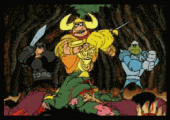
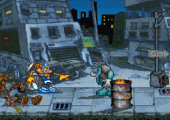
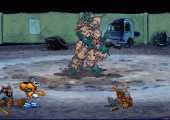
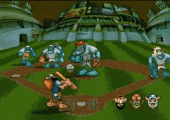
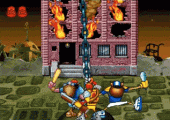
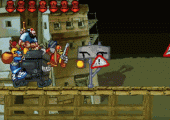
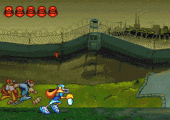
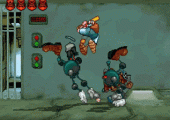
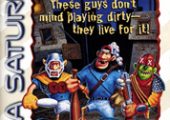
Recent Comments